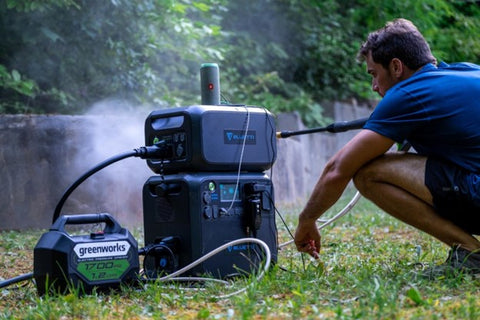Clean energy is critical for any society's progress and prosperity. Despite that, many communities and regions around the world continue to lack access to reliable and inexpensive electrical sources. Due to their location, difficult terrain, and high installation costs, remote places, in particular, frequently confront considerable challenges in reaching the grid. As a result, many communities are reliant on conventional energy sources, such as diesel generators, which can be costly, noisy, and environmentally harmful.
However, portable solar generators provide a green and lasting solution to this problem, providing people who live in remote areas with an alternative source of power and a way to improve their lives.
Advantages of Portable Solar Generators for Remote Areas
1) Clean and Renewable Energy
Portable solar generators harness the sun's renewable energy, making them a clean and sustainable source of electricity. They do not produce any contaminants or toxic gases, and can thus be used in different environments.
2) Portable and Silent
Portable solar generators are lightweight and compact, making them simple to carry and store. Since they do not produce any noise while operating, they can be used in campsites, residential areas, and other noise-sensitive locations.
3) Low Maintenance
The lack of moving parts means portable solar generators have pretty much no components that would require repairs or maintenance. Thus, these generators can easily last upwards of 20 years, even with very little upkeep.
4) Limitless Power Source
Since portable solar generators harness the sun’s energy to create electricity, they can continue to do their job effectively as long as they get regular exposure to sunlight.
5) Cost-Effective
Although portable solar generators require a higher upfront investment than conventional ones, they more than compensate for it: not only do they not require expensive fuel or regular maintenance, but they can also reduce or even eliminate your monthly electricity bills.
6) Versatile
Portable solar generators can power a variety of electronics and appliances, including lights, fans, televisions, laptop computers, and tiny refrigerators.
Portable Solar Generator Applications for Remote Areas
1) Rural Electrification
Portable solar generators can be used to power remote areas that are not linked to the power grid. This can improve people's quality of life in rural locations by providing access to important services like lighting, communication, and healthcare.
2) Disaster Relief
Portable solar generators can be utilized in emergency scenarios to provide a consistent source of electricity for rescue and relief efforts. During power outages, they can also be used to power essential appliances, such as refrigerators and medical equipment.
3) Off-Grid Living
Homes and chalets in rural places that are not linked to the grid can be powered by portable solar generators. These generators can provide a cost-effective and environmentally-friendly alternative to conventional energy sources, such as diesel generators.
4) Outdoor Activities
During outdoor activities like camping, hiking, or RV travels, a portable solar generator can help power electronics and appliances. They can supply a safe and dependable source of energy for lighting, cooking, and entertainment.
The Environmental Benefits of Portable Solar Panels in Remote Areas
Portable solar generators have numerous environmental benefits, particularly in isolated regions where regular sources of power are unavailable or environmentally hazardous.
Here are some of the ways in which portable solar generators can benefit the environment:
1) Lower Dependence on Fossil Fuels
Solar energy, which is used by portable solar generators, is eco-friendly and sustainable. It lessens our reliance on fossil fuels like coal, oil, and gas, all of which contribute to greenhouse gas emissions and climate change.
2) Zero Emissions
One key reason that portable solar generators are considered environmentally-friendly is that they release no harmful gases or other toxins. They do not contribute to air, water, or soil pollution, and are thus suitable for any environment.
3) Conservation of Natural Resources
No fuel, oil changes, or filter replacements are required for portable solar generators, lowering the need for natural resources, such as oil and gas.
They also do not require any water for cooling, in contrast to traditional power plants that use a lot of water.
4) Preservation of Biodiversity
Extracting conventional energy sources like coal and oil can have a significant impact on the surrounding wildlife habitat and biodiversity. On the other hand, portable solar generators have a low environmental impact, making them a sustainable and eco-friendly option.
5) Improvement in Air Quality
Portable solar generators produce no pollutants or harmful emissions, improving air quality in rural regions. This is especially important for places that use diesel generators, which can release harmful gases like carbon monoxide and nitrogen oxides into the air.
6) Reduced Noise Pollution
Portable solar generators run quietly, making them ideal for usage in noise-sensitive locations, such as homes, campgrounds, and animal habitats. This minimizes noise pollution, which has a negative influence on both human and wildlife health.
Case Studies – How Portable Solar Generators Are Changing Lives in Remote Communities
Portable solar generators have the potential to change the lives of people living in isolated communities by giving them access to clean, long-lasting electricity. The below case studies portray how portable solar generators have had a life-changing impact on rural communities around the world:
1) Uganda – Solar-Powered Health Clinics
Access to reliable power is scarce in Uganda, particularly in rural regions. This makes it impossible for health centers to provide important medical services, such as vaccination refrigeration and drug storage.
Solar Health Uganda, a non-profit group, placed portable solar generators in health clinics across the country to address this issue. These generators provide a consistent source of electricity for illumination, medical equipment, and refrigeration, improving healthcare quality for those living in remote places.
2) India – Solar-Powered Irrigation

Access to water for agriculture is a major problem in many rural Indian areas. To address this issue, the non-profit group Husk Power Systems installed portable solar generators to power irrigation systems in remote villages.
These generators provide a long-term and dependable source of power, reducing reliance on diesel generators and boosting crop yields. Portable solar generators have also improved farmers' quality of life by offering reliable electricity for lighting, cooking, and communication.
3) Tanzania –Solar-Powered Education
Due to a lack of electricity, many rural areas in Tanzania have restricted access to schooling. Solar Sister, a non-profit organization, placed portable solar generators in schools to power lighting, fans, and computers to address this issue.
These generators have improved education by offering a safe and well-lit learning environment. Portable solar generators have also increased access to digital technology, which has improved educational quality and increased the potential for economic growth.
4) Nepal – Solar-Powered Disaster Relief
Natural disasters like earthquakes and landslides are prevalent in Nepal, and often lead to extensive damage and displacement.
The NGO, SunFarmer, installed portable solar generators in disaster-prone regions to provide emergency power. During emergencies, these generators have provided a dependable source of power for lighting, communication, and medical apparatus, enhancing response and recovery efforts. Portable solar generators have also given communities in the aftermath of disasters a sustainable and clean source of power.
Overcoming Barriers to Adoption – Financing, Education, and Infrastructure Challenges
In order for rural and remote areas to benefit from portable solar generators, there are several barriers to adoption that need to be acknowledged and overcome, which include:
1) Financial Barriers
Portable solar generators can be costly, putting them out of reach for many people and communities in remote areas. Micro-financing, government subsidies, and crowd-sourcing are just a few of the ways that portable solar generators can be made more affordable. Subsidies and tax breaks can also be provided by governments and non-profit groups to encourage the use of portable solar generators.
2) Education Barriers
Many people and communities in outlying areas may be unfamiliar with portable solar generators and how they function.
Portable solar generators can benefit from increased understanding and adoption through education and awareness initiatives. Workshops and training sessions on how to use and maintain portable solar generators can also be conducted.
3) Infrastructure Barriers
The need for sunlight may make portable solar generators less effective in areas without enough sunlit hours. However, technological advancements have resulted in the creation of more efficient and cost-effective portable solar generators capable of operating in low-light conditions.
Governments and non-profit groups can also help to fund the installation of charging stations in rural areas, which will expand access to portable solar generators.
4) Supply-Chain Barriers
The supply chain for portable solar generators can be complicated, making distribution to remote regions challenging.
Governments and non-profit organizations can collaborate with local partners to create supply chains that effectively distribute portable solar generators to outlying communities. This can also help to generate local jobs and boost economic development.
How Governments and NGOs are supporting the Adoption of Portable Solar Generators in Remote Areas
The role of governments and NGOs is critical in promoting the use of portable solar generators in remote regions.
Here are some methods that governments and non-governmental organizations are encouraging the use of portable solar generators:
1) Funding and Subsidies
Governments and NGOs are providing funding and subsidies to encourage the use of portable solar generators in remote regions. This money could be used to subsidize the purchase of portable solar generators or to assist community-based solar projects.
For example, the World Bank's Lighting Global program provides funding and support to businesses and groups working to increase access to clean, affordable, and dependable off-grid lighting and energy solutions.
2) Policy and Regulatory Support
Governments are developing policies and regulations to help rural communities install and use portable solar generators. This includes policies that promote the use of renewable energy sources, regulations that require the installation of solar panels on new structures, and tax incentives for investments in renewable energy.
3) Capacity Building
NGOs and governments also provide capacity-building and training programs to streamline the process of portable solar generator adoption in rural areas. This includes instruction on how to install and maintain solar panels, as well as how to use portable solar generators and handle community-based solar projects.
The International Renewable Energy Agency (IRENA), for example, provides a variety of training and capacity-building programs to help developing countries deploy renewable energy.
4) Partnerships and Collaborations
Governments and NGOs are collaborating with private sector businesses and local groups to increase portable solar generator adoption in remote regions.
Partnerships with local groups that can aid in distribution, installation, and upkeep are part of this strategy, as is collaboration with manufacturers and distributors of portable solar generators. In sub-Saharan Africa, for instance, the Energy Access Project at Duke University collaborates with local organizations to distribute and implement solar-powered micro-grids in remote communities.
5) Awareness Campaigns
Finally, NGOs and governments are spreading the word about the importance and benefits of portable solar power solutions in rural areas. This includes public awareness campaigns highlighting the benefits of portable solar generators and their potential to provide pure, reliable, and affordable energy in remote locations.
The Sustainable Energy for All initiative of the United Nations, for instance, conducts public awareness campaigns to encourage the adoption of renewable energy solutions in developing nations.
Connecting the Unconnected – How Portable Solar Generators Can Help Empower Rural and Remote Areas

Portable solar generators can give people in remote areas a reliable and long-lasting way to obtain power. With improvements in technology and increasing adoption, portable solar generators can give people access to clean, affordable, and reliable energy, enhancing the quality of life for rural populations.
If you want to learn more about how our products can help remote communities, we invite you to check out our wide range of portable solar generators and other solutions.




